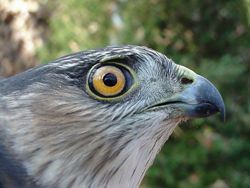 HOME: www.hiltonpond.org |
|
||
|
|
|||
|
|
|||
|
|
|||
|
|
|||
|
|
|||
|
|
THIS WEEK at |
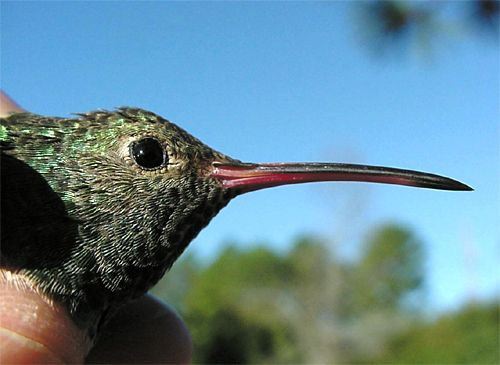 All photos & text © Hilton Pond Center Buff-bellied Hummingbird On 3 December 2001, Hilton Pond Center received a message from Cathleen Lee, stating that an unusual hummingbird was coming to her front porch feeder in Lexington County, South Carolina (near Columbia). Ms. Lee, a teacher at Lake Murray Elementary School, had attended a session about "Operation RubyThroat: The Hummingbird Project" just a month earlier, when Center director Bill Hilton Jr. spoke at the South Carolina Science Council and advised the audience to maintain hummingbird feeders in winter.
On 4 December Hilton journeyed to the Lee residence, arriving at 7:30 a.m. to set up his portable trap containing a hummingbird feeder. Within ten minutes a large hummingbird began investigating but did not enter the trap. The hummer did linger to feed at a hanging basket of late-blooming Pentas, and while hovering at the pink flowers the bird's bright rusty tail feathers were visible from the rear (right). Between flower and trap visits the hummer perched in a deciduous tree facing the observer and revealed its green gorget and breast, light-colored belly, and red-orange bill (below left). As implied by its species name, Amazilia yucatanensis, the buff-bellied is a bird of Mexico's Yucatan region, with a year-round range from the Yucatan peninsula northward along the Gulf Coast to south Texas. In recent years, there have been reports of Buff-bellied Hummingbirds wandering into several Gulf Coast states and elsewhere, but none in the Carolinas until now. Once he had the bird in hand, Hilton was able to examine the bird closely in an attempt to determine its age and sex. The overall intensity of color in the rusty tail and uniformly iridescent green breast and throat suggested that the bird was an adult, especially when a hand lens revealed the absence of tiny grooves in the bill that are usually indicative of young hummingbirds. Although many hummingbird species--including the Ruby-throated Hummingbirds common to the Carolinas--show sexual dimorphism in their adult plumage, sexes are alike in the Buff-bellied Hummingbird.
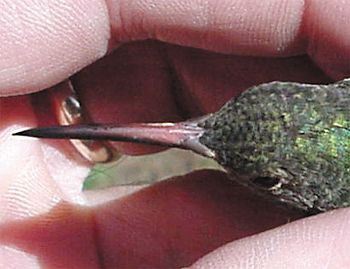
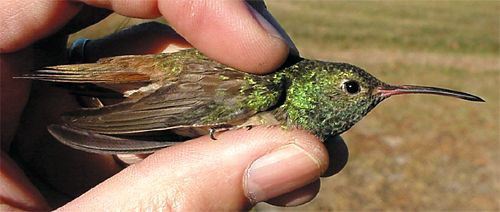
NOTE:A story about the capture and banding of the Buff-bellied Hummingbird appeared in The State on 8 December 2001. See No one can explain why Mexican hummingbird has made its home in S.C. In order to get a better understanding of hummingbird behavior in North America, it is important to report all sightings of vagrant and winter hummingbirds so banders can capture and positively identify as many individuals as possible. Especially in the Carolinas, send sightings of non-rubythroats (or ruby-throats in winter) to RESEARCH. Information about vagrant or winter hummingbirds--i.e., any hummingbird seen between 15 October and 15 March in the Eastern U.S. or Canada--will be forwarded to a bander in the nationwide network who is close enough to visit the site for possible capture. See also Research on Winter Vagrant Hummingbirds. If you enjoy "This Week at Hilton Pond," please help Support Hilton Pond Center for Piedmont Natural History. It's painless, and YOU can make a difference! You may wish to consult our Index of all nature topics covered since February 2000. |

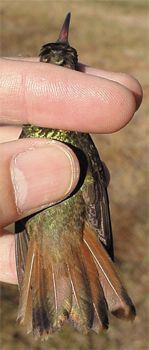 In a subsequent phone conversation with Hilton, Ms. Lee said she had suspected a vagrant hummer was in the neighborhood when the sugar water level in her feeder began dropping rapidly during the last week in November. On 1 December, she got several quick looks at a "large hummingbird with a red-orange bill" and was able to contact Hilton two days later about the sightings.
In a subsequent phone conversation with Hilton, Ms. Lee said she had suspected a vagrant hummer was in the neighborhood when the sugar water level in her feeder began dropping rapidly during the last week in November. On 1 December, she got several quick looks at a "large hummingbird with a red-orange bill" and was able to contact Hilton two days later about the sightings.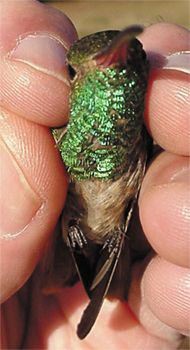 Even through binoculars there was no question about this bird's identity: Buff-bellied Hummingbird. When the hummer finally entered the trap at 8:30 a.m., Hilton pulled the string and had a new record for South Carolina--the first Buff-bellied Hummingbird ever seen or banded in the state.
Even through binoculars there was no question about this bird's identity: Buff-bellied Hummingbird. When the hummer finally entered the trap at 8:30 a.m., Hilton pulled the string and had a new record for South Carolina--the first Buff-bellied Hummingbird ever seen or banded in the state.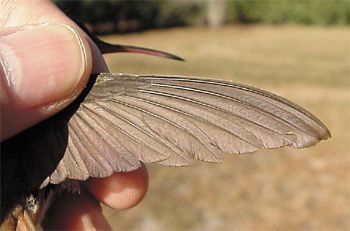 Sexing the bird was more difficult. In the words of hummingbird expert Nancy Newfield, "the Buff-bellied Hummingbird is the most poorly studied hummingbird that breeds in North America north of Mexico. You could fill a book with what we don't know about them," including their external sexual differences.
Sexing the bird was more difficult. In the words of hummingbird expert Nancy Newfield, "the Buff-bellied Hummingbird is the most poorly studied hummingbird that breeds in North America north of Mexico. You could fill a book with what we don't know about them," including their external sexual differences.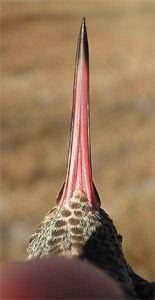 Some experts report sexual differences with regard to tail and wing measurements, but overlap in these still makes sexing difficult. The South Carolina bird measured as follows: weight 5.3 g; wing chord 54.7 mm; culmen 21 mm; and tail 35.5 mm, with a slight tail notch that was 3 mm deep. Adult male buff-bellieds typically have deeper tail notches and extensive red on the upper bill--the newly captured hummer showed mostly black (top photo)--and older adult females are reported to show whitish chins, which this bird did not. The bird's tail was somewhat tattered and with a few feather tips broken off; this suggests that the bird in hand was a female whose tail was abraded when she sat on a nest incubating eggs during the most recent breeding season. All these observations suggest that the hummer was a female. However, short of an internal examination or DNA test the sex could not be determined conclusively, so the bird will be reported to the federal Bird Banding Lab as an adult Buff-bellied Hummingbird of unknown sex. The bird surely knows, but we do not.
Some experts report sexual differences with regard to tail and wing measurements, but overlap in these still makes sexing difficult. The South Carolina bird measured as follows: weight 5.3 g; wing chord 54.7 mm; culmen 21 mm; and tail 35.5 mm, with a slight tail notch that was 3 mm deep. Adult male buff-bellieds typically have deeper tail notches and extensive red on the upper bill--the newly captured hummer showed mostly black (top photo)--and older adult females are reported to show whitish chins, which this bird did not. The bird's tail was somewhat tattered and with a few feather tips broken off; this suggests that the bird in hand was a female whose tail was abraded when she sat on a nest incubating eggs during the most recent breeding season. All these observations suggest that the hummer was a female. However, short of an internal examination or DNA test the sex could not be determined conclusively, so the bird will be reported to the federal Bird Banding Lab as an adult Buff-bellied Hummingbird of unknown sex. The bird surely knows, but we do not.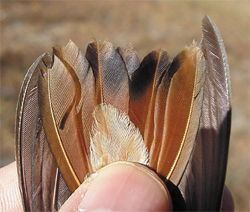 As measurements were completed, the hummer received band number Y14780 on its right leg. Then Hilton slid the bird's bill into the hummingbird feeder and watched as it took several long drinks of sugar water. Finally, as an appropriate reward for being the first person to see and report a Buff-bellied Hummingbird in South Carolina, Cathleen Lee held and released the bird, which returned to the feeder several times over the next hour.
As measurements were completed, the hummer received band number Y14780 on its right leg. Then Hilton slid the bird's bill into the hummingbird feeder and watched as it took several long drinks of sugar water. Finally, as an appropriate reward for being the first person to see and report a Buff-bellied Hummingbird in South Carolina, Cathleen Lee held and released the bird, which returned to the feeder several times over the next hour.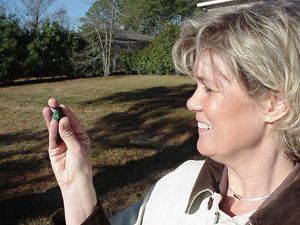 One of the rewarding aspects of the banding process was that Stephanie Lee, Cathleen's daughter and a senior at White Knoll High School, was permitted to miss part of the school day to watch the procedure. Having seen the brilliant green iridescent plumage on the family's very own Buff-bellied Hummingbird, Stephanie now has first-hand knowledge of structural color in nature--which will put her in good stead in that physics class she is now taking.
One of the rewarding aspects of the banding process was that Stephanie Lee, Cathleen's daughter and a senior at White Knoll High School, was permitted to miss part of the school day to watch the procedure. Having seen the brilliant green iridescent plumage on the family's very own Buff-bellied Hummingbird, Stephanie now has first-hand knowledge of structural color in nature--which will put her in good stead in that physics class she is now taking.